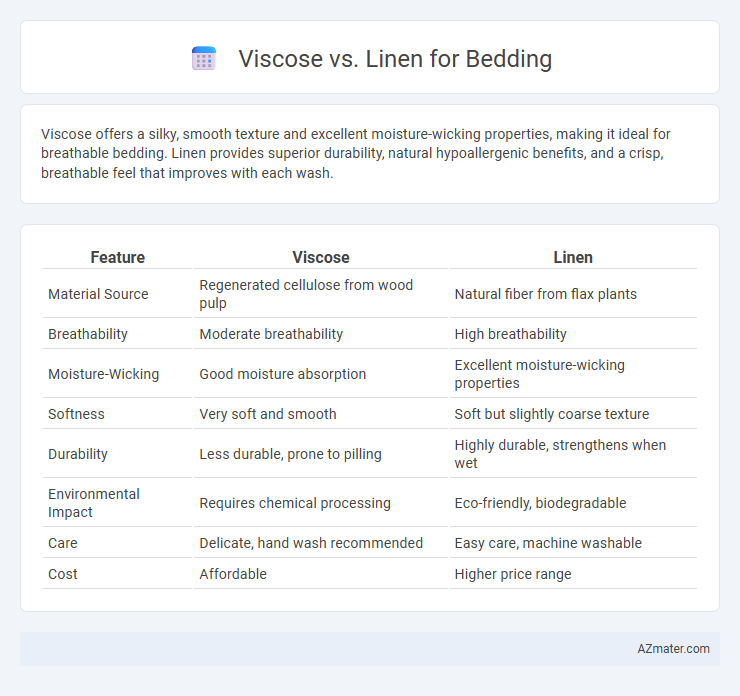Viscose offers a silky, smooth texture and excellent moisture-wicking properties, making it ideal for breathable bedding. Linen provides superior durability, natural hypoallergenic benefits, and a crisp, breathable feel that improves with each wash.
Table of Comparison
| Feature | Viscose | Linen |
|---|---|---|
| Material Source | Regenerated cellulose from wood pulp | Natural fiber from flax plants |
| Breathability | Moderate breathability | High breathability |
| Moisture-Wicking | Good moisture absorption | Excellent moisture-wicking properties |
| Softness | Very soft and smooth | Soft but slightly coarse texture |
| Durability | Less durable, prone to pilling | Highly durable, strengthens when wet |
| Environmental Impact | Requires chemical processing | Eco-friendly, biodegradable |
| Care | Delicate, hand wash recommended | Easy care, machine washable |
| Cost | Affordable | Higher price range |
Introduction to Viscose and Linen Bedding
Viscose bedding, crafted from regenerated cellulose fibers, offers a smooth, silky texture with exceptional breathability and moisture-wicking properties, ideal for maintaining a cool and comfortable sleep environment. Linen bedding, made from flax fibers, is renowned for its durability, natural hypoallergenic qualities, and excellent temperature regulation, providing a crisp, textured feel that softens over time. Both materials are eco-friendly options, with viscose offering a more affordable luxury and linen delivering long-lasting performance.
Material Origins: Viscose vs Linen
Viscose is a semi-synthetic fiber derived from cellulose sources such as wood pulp, primarily processed through chemical treatments to create soft, smooth fabric. Linen is made from the natural fibers of the flax plant, known for its strength, breathability, and durability. The key difference in material origins lies in viscose's chemically regenerated cellulose versus linen's direct extraction from flax fibers, impacting their texture, sustainability, and overall feel in bedding applications.
Texture and Feel: Comfort Comparison
Viscose bedding offers a silky, smooth texture that feels cool and breathable against the skin, making it ideal for hot sleepers and humid climates. Linen bedding, on the other hand, provides a textured, slightly coarse feel that softens with each wash, offering a naturally breathable and moisture-wicking comfort perfect for year-round use. The comfort comparison highlights viscose's luxurious softness versus linen's durable, airy fabric, catering to different preferences for tactile sensation and temperature regulation.
Breathability and Temperature Regulation
Viscose fibers offer excellent breathability due to their moisture-wicking properties, making them effective at regulating body temperature during sleep. Linen excels in air permeability and durability, allowing heat and moisture to escape easily, which keeps sleepers cool in warm climates. Both materials provide natural temperature regulation, but linen's coarser texture enhances airflow more than the smooth, soft surface of viscose.
Moisture Wicking and Absorbency
Viscose bedding excels in moisture wicking due to its smooth fiber structure, which allows it to pull moisture away from the skin quickly, making it ideal for hot and humid climates. Linen, made from flax fibers, boasts superior absorbency and breathability, absorbing up to 20-30% of its weight in moisture without feeling damp, which helps regulate body temperature effectively. Both materials offer excellent moisture management, but linen's natural fibers provide better durability and enhanced moisture absorption for all-night comfort.
Durability and Longevity
Linen bedding outperforms viscose in terms of durability and longevity due to its natural flax fiber composition, which is highly resistant to wear and tear. Viscose, made from regenerated cellulose fibers, tends to weaken over time, especially with frequent washing and exposure to moisture. High-quality linen improves in softness and strength with age, making it a long-lasting option for bedding that maintains its integrity for years.
Care and Maintenance Requirements
Viscose bedding requires gentle washing with cold water and air drying to maintain its softness and prevent shrinking, while linen is more durable, tolerating machine washing at higher temperatures and becoming softer with each wash. Linen is naturally moisture-wicking and resistant to bacteria, making it easier to maintain without frequent replacements. Both materials benefit from avoiding harsh detergents and excessive heat to prolong their lifespan and preserve fabric integrity.
Eco-Friendliness and Sustainability
Viscose, derived from wood pulp, involves chemical-intensive production processes that raise concerns about environmental impact and sustainability when used for bedding. Linen, made from flax fibers, is highly eco-friendly due to its minimal water usage, natural biodegradability, and low pesticide requirements, making it a sustainable choice for bedding. Choosing linen over viscose supports reduced chemical pollution and promotes a more sustainable textile industry.
Cost Comparison: Viscose vs Linen
Viscose bedding typically costs significantly less than linen, making it a budget-friendly option for consumers seeking softness and breathability. Linen, known for its durability and natural moisture-wicking properties, commands a higher price due to its labor-intensive production and premium material quality. Choosing between viscose and linen often depends on balancing upfront cost versus long-term investment in bedding longevity and performance.
Which is Better for Bedding: Viscose or Linen?
Viscose offers a soft, silky texture with excellent moisture-wicking properties, making it ideal for breathability and comfort in bedding. Linen, derived from flax fibers, is highly durable, promotes airflow, and naturally resists bacteria and allergens, enhancing mattress hygiene and longevity. For those seeking a blend of softness and sustainable durability, combining viscose and linen bedding can optimize comfort and resilience.

Infographic: Viscose vs Linen for Bedding
 azmater.com
azmater.com